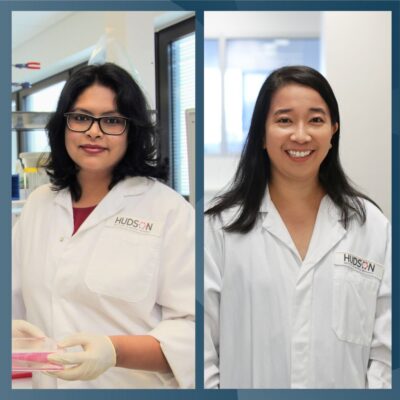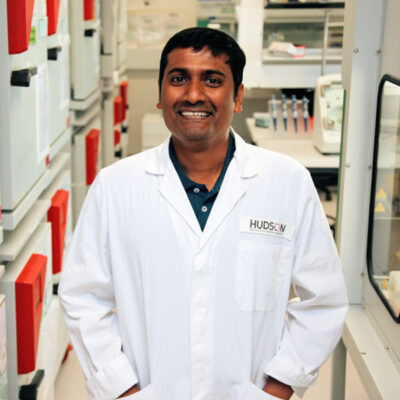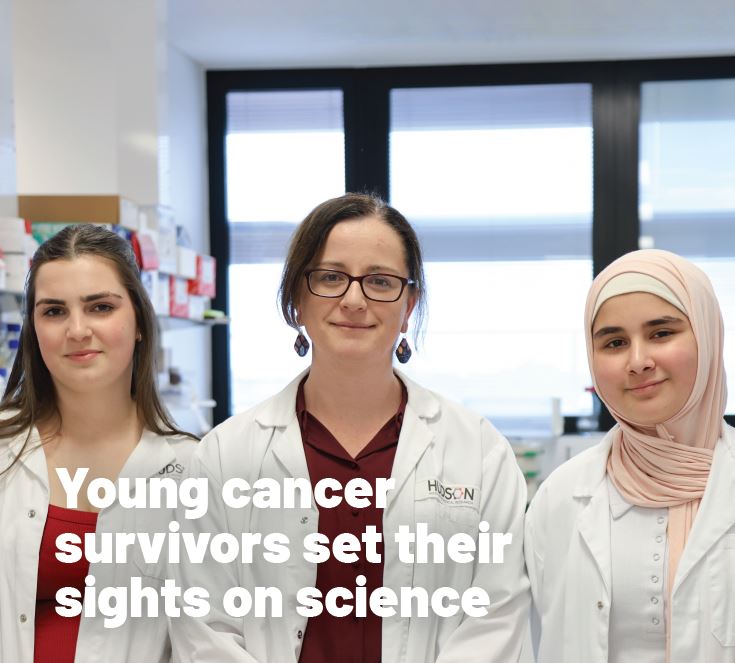Bioengineering: the new approach for treating pelvic organ prolapse
By Hudson Institute communications. Reviewed by Professor Caroline Gargett
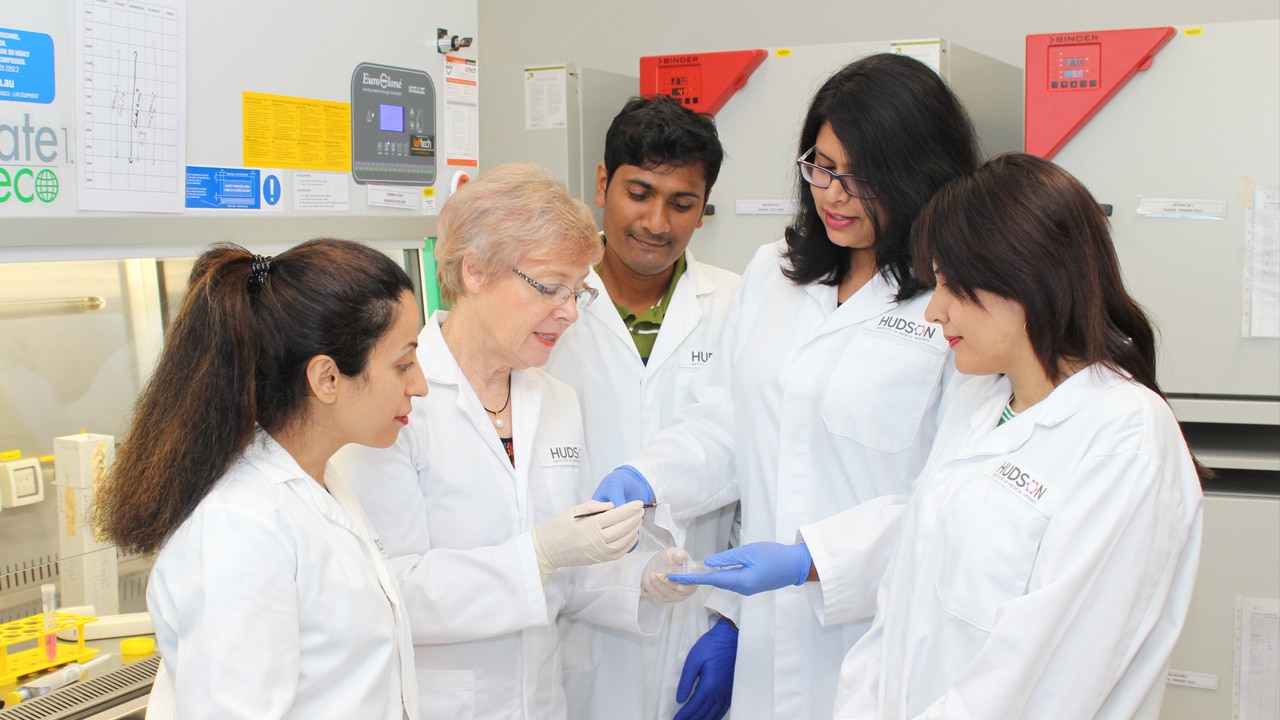
Hudson Institute of Medical Research scientists are combining stem cells from the lining of a woman’s own uterus with nanobiomaterials (biodegradable materials engineered on the nanoscale) in a world-first approach to develop safer, more effective treatments for pelvic organ prolapse.
What is pelvic organ prolapse (POP)?
- Pelvic Organ Prolapse (POP) develops when tissues, pelvic floor muscles and ligaments that support the pelvic organs (bladder, uterus and bowel), become damaged, usually in childbirth, causing organs to shift or ‘drop’ into the vagina or even outside the body. This can lead to debilitating symptoms, including poor bladder or bowel control and pain during sex. This may profoundly affect a woman’s quality of life.
- POP may be exacerbated by other factors such as age, ethnicity, the number of times a woman has given birth, obesity and their family genetics. POP is exacerbated by menopause – one in two postmenopausal women who have had children will experience POP, compared to one in four women generally.
- Up to a third of women with POP require multiple treatments in their lifetime
Professor Caroline Gargett, Head of the Endometrial Stem Cell Biology group that is leading the research, says the ultimate aim is to restore quality of life to women with pelvic organ prolapse, and to prevent the condition from occurring in younger women.
Pelvic organ prolapse (POP) is a lifelong, potentially debilitating condition, predominantly caused by the impact of childbirth. It affects an estimated one in four women, and around one in two women aged over 50.
Prof Gargett has found in preclinical studies that delivering adult stem cells from the highly regenerative womb lining to sites of injury promotes growth of new blood vessels and collagen to repair tissue.
Her team is now translating these findings to POP, by developing a new treatment using a bio-construct made of microscopic fibres to deliver endometrial stem cells to areas of damage in the vaginal walls.
A world-first approach
Seven years in the making, the multi-disciplinary project includes collaborators from Hudson Institute, CSIRO, Flinders University, Monash Institute of Medical Engineering (MIME) and Associate Professor Anna Rosamilia, head of the Pelvic Floor Unit at Monash Health.
“We have shown in preclinical studies that endometrial stem cells differentiate into the types of cells that are required in the vaginal walls,” Prof Gargett says.
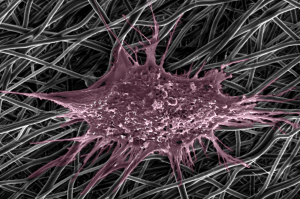
“We believe endometrial stem cells have real potential in treating pelvic organ prolapse. We have shown in mice that the cells produced factors that ‘trick’ the body or modify the immune response to one of healing, rather than scarring, which helps to repair the damage.”
The team, including SIEF John Stocker Postdoctoral Fellow Dr Shayanti Mukherjee, is developing a scaffold using biocompatible materials such as gelatin to ‘anchor’ endometrial stem cells to sites of injury where they can repair and promote the grow of the tissues that hold the pelvic organs in place.
‘Anchoring’ stem cells
Historically, transvaginal meshes used in pelvic organ prolapse surgeries have been made from thermoplastic polymer polypropylene, a type of plastic also used in plastic containers.
In November 2017, the Therapeutic Goods Administration announced it would remove vaginal meshes used for treating pelvic organ prolapse from the register for sale in Australia. A class action is also underway on behalf of women seeking redress for adverse side effects of transvaginal meshes.
What are endometrial stem cells?
Endometrial stem/progenitor cells are types of adult stem cells found in the lining of the uterus or womb. Adult stem cells are rare cells that have now been found in almost all organs of the body. They are unspecialised cells that divide and renew themselves but at the same time generate the specialised cells of the organ or tissue in which they reside for the entire lifespan. Adult stem cells are particularly important in rapidly growing tissues and those that undergo regeneration, such as the endometrium.
Dr Mukherjee says nanotechnology is key to designing materials that mimic the natural tissues in the vaginal walls. A bio-construct of nanobiomaterials would be placed within the vaginal walls to deliver stem cells to sites of injury to promote tissue repair, before naturally disintegrating after a year or two like a suture.
“The fibres in the nanomaterials we’re working with are over 1000 times smaller than the transvaginal meshes used for pelvic organ prolapse in the past. This provides a more optimal matrix for cells to attach and grow, thereby promoting healing. The bio-construct we’re designing is thin, like a sheet of tissue paper, with flexibility that allows it to move as the tissues in the body move,” Dr Mukherjee explains.
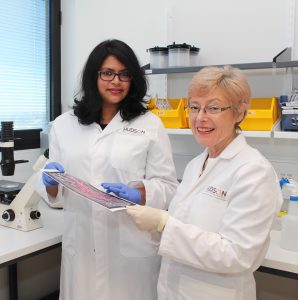
In addition, the team, in collaboration with Flinders University, is developing a novel fibre optic probe to better monitor and classify damage to the vagina. Their aim is to develop a method to more accurately diagnose areas of weakness associated with POP and better target stem cell treatments to those areas.
New treatment in three to five years
However, a clinical trial is not expected for at least another three to five years. Before the treatment can reach women, it must first undergo a rigorous process of preclinical testing to show long-term safety and efficacy, as well as research ethics and Therapeutic Goods Administration approvals.
“We know that women and clinicians are calling out for safer, more effective treatments and we are working to deliver these options,” Prof Gargett says.
Prof Gargett recently presented her team’s findings to a gathering of world experts in tissue regeneration, bioengineering and pelvic floor disorders at the Royal Society in London.
This research was supported by | CASS Foundation, LEW Carty Charitable Fund, a Monash Institute of Medical Engineering (MIME) Seed Funding Grant, National Health and Medical Research Council (NHMRC), The Royal Australian and New Zealand College of Obstetricians and Gynaecologists (RANZCOG), Research Infrastructure Support Services (RISS), Rebecca L Cooper Medical Research Foundation, Science and Industry Endowment Fund (SIEF), SMART, Youanmi Foundation
In this article
About Hudson Institute
Hudson Institute’ s research programs deliver in three areas of medical need – inflammation, cancer, women’s and newborn health. More
Hudson News
Get the inside view on discoveries and patient stories
“Thank you Hudson Institute researchers. Your work brings such hope to all women with ovarian cancer knowing that potentially women in the future won't have to go through what we have!”

